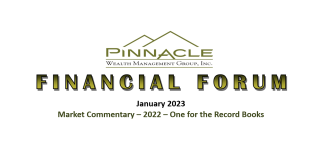
Financial Forum January 2023
Market Commentary – 2022 – One for the Record Books
2022 started off with hope and promise as the world looked forward to a year without a crippling pandemic, or at least, a world where COVID could be managed. However, hope was quickly replaced with reality, as supply chain disruptions, worker shortages, and one of the biggest wars in decades in Europe caused inflation to surge to its highest level in 40 years, forcing the U.S. Federal Reserve to hike interest rates by 4.25%, with the promise of more rate hikes to come. When the ink was dry on the year, the S&P 500 shed 19.4%, its fourth-worst annual decline since its official inception in 1957, according to Dow Jones Market Data. The value-oriented Dow Jones Industrial Average lost 8.8%, while the tech-heavy NASDAQ Composite lost 33%. All three indexes locked in their worst year since the 2008 financial crisis. Some of the NASDAQ’s previous sweethearts got crushed – Tesla and Meta (formerly Facebook) lost 65%, NVIDIA and Amazon wiped out half of their market values, Google dropped 40%, while Microsoft and Apple lost around 30%. Bitcoin was down 70% from its peak. Meanwhile, on the fixed income side, bonds, as measured by the Bloomberg U.S. Bond Aggregate Index, had their worst performance since that index’s inception in 1976, losing 13%. In the preceding 45 years, bonds had fallen in value only five times, and the most significant decline was a mere 2.9% in 1994.
With both stocks and bonds losing value last year, it would follow that the classic balanced (60/40) portfolio would also struggle. And that it did. According to LPL Financial, 2022 marked the second worst year on record for this allocation, again going back to its inception in 1976. For the year, a portfolio allocated 60% into the S&P 500 and 40% into the Bloomberg Aggregate Bond Index lost 17%, providing investors with little protection from the market carnage. Only in 2008, did this allocation perform worse, losing 20% that year.
If the Fed’s easing money policies after the pandemic caused a speculative frenzy in most asset classes, then last year’s tightening policies by the central bank certainly reversed those gains. Besides bonds and the mega cap tech stocks mentioned above, meme stocks, SPACs, money-losing unicorn companies, initial public offerings, private equity investments, cryptocurrencies and their exchanges, and housing all took hits. Ask anyone who has ever fallen off a ladder, gravity always wins. The Fed created the biggest asset bubble in our history by increasing the M2 money supply since COVID by about 40% and now they have only two choices: unacceptable high inflation or a big recession. Let’s hope we don’t get both.
Market Risks in 2023
As we enter the new year, investors will remain focused on inflation, interest rates, and corporate profit forecasts. Inflation has already proved to be more than transitory. Supply chains are still clogged, and labor costs remain elevated. For the Fed, rampant wage growth is worrisome because it fuels inflation in the service sector, which is a broad-based and stickier inflation. This forces the Fed to keep rates higher for longer, in an attempt to bring down demand. Additionally, higher wages cut into profit margins. After years of record margins, companies are now struggling to keep their costs under control. And, with the economy slowing, this suggests that corporate profit estimates are still too high; their reductions should put additional pressure on equity valuations in the new year. Lastly, after trending lower throughout 2022, the yield curve is now deeply inverted. The 10-year U.S. Treasury yield less the 2-year yield now stands at levels not seen since the 1980s. This is concerning because the yield curve has a strong track record in predicting recessions with very few false positives over recent decades.
The Next Decade
As uncertainty continues to dominate markets in the beginning of 2023, one thing remains clear: The path to wealth over the next decade will look very different than it has over the past 10 years. The bull market that powered annual high teen gains since 2009 is gone, and in its place is an environment where investors need to
be much more strategic than years’ past. Markets are mean reverting. Therefore, if you have above-trend returns for a long period of time, they will eventually be followed by below-trend returns to get you back to the long-term average returns. Vanguard is currently projecting nominal annual stock returns in the 4.7% to 6.7% range for stocks and 4% to 5% for bonds over the next decade. Those moderate return expectations leave investors less room for poor decisions. We recommend customized planning and investment strategies that are continuously monitored to help ensure a high probability that you achieve your goals.
The SECURE 2.0 Act
In the closing days of 2022, President Biden signed into law a sweeping spending bill to fund the federal government into next year and avert a shutdown. Also in the law were some changes to the rules regarding retirement savings. Here are the some of those new rules:
Raising the age for required minimum distributions (RMD). The SECURE 2.0 Act of 2022 aims to make it easier for Americans to save for retirement by, among other things, raising the RMD age to 73 on January 1, 2023, and then to age 75 on January 1, 2033.
Catch-up contributions. Workers who haven’t saved enough for retirement throughout their careers sometimes scramble to make up the shortfall as they approach the end of their working life. The bill increases the limits for making so-called catch-up contributions for employees ages 60 through 63. Starting in 2025, the limit for catch-up contributions for savers in that age range would increase from $7,500 a year to at least $11,250.
Help for student loan debt. The burden of student loan debt can be a major impediment to saving for retirement. After all, it can be hard to pay down debt while also putting money away for retirement. The Secure 2.0 Act permits employers to make matching contributions to a retirement plan based on qualified student loan repayments. So even if a borrower can’t afford to contribute money to a retirement plan, they can still start building a nest egg through their employer match.
Quarterly thought…Happy New Year
From our family to yours…Be the best you can be in ’23!
To learn more, call our office or CLICK HERE to request a meeting today!
(734) 667-5581
Pinnacle Wealth Management Group, Inc.
www.pwmgi.com
849 Penniman Ave, Suite 201, Plymouth, MI 48170
Securities offered through Private Client Services, Member FINRA/SIPC. Advisory products and services offered through Pinnacle Wealth Management Group, Inc., a Registered Investment Advisor. Private Client Services and Pinnacle Wealth Management Group, Inc., are unaffiliated entities.

